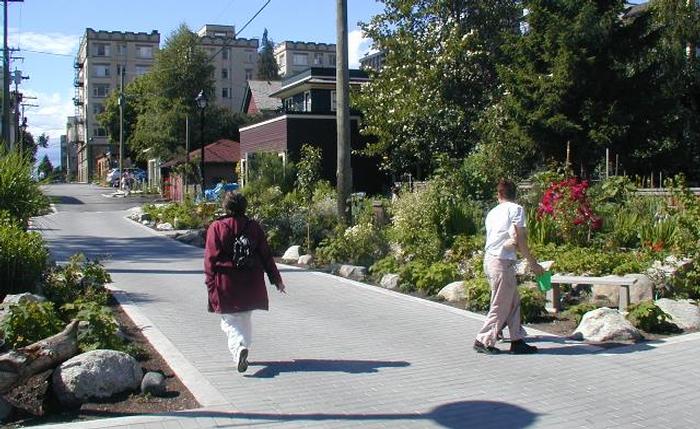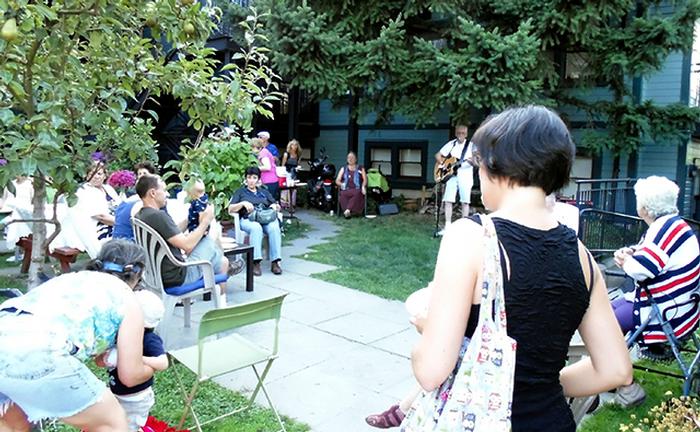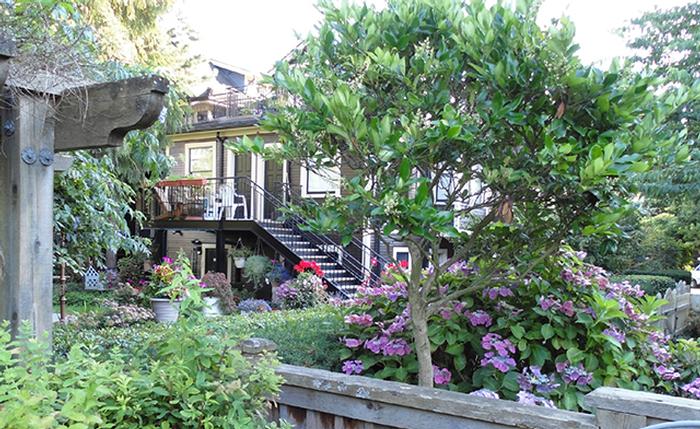[ID:932] Building the In Between Spaces into a Healthful EnvironmentCanada There are many things that contribute to an environment. It includes the living and non-living things, the culture that individuals live in, and the constructed surroundings that provide the setting for human activity. All these attributes can be found everywhere amongst us. They include our homes, work place, public spaces, and even in the unnoticeable spaces we take for granted: the spaces in between.
Humans are a species with as much need for the natural environment as any other. However, we are also a social species that thrives in towns and cities and has prospered with the use of technology. But neither technology nor cities can replace our need for the natural environment. We have to keep a balance. By disconnecting from our natural environment, we have become strangers to the natural world. This has challenged our sense of identity and in some subtle ways has had a significant affect on our health. By integrating well-designed pedestrian paths and green spaces into our communities, we can create a healthful social environment that can provide numerous benefits to a person’s physical and psychological well being.
The Mole Hill Revitalization Project in Vancouver is an example of integrating pedestrian paths and green spaces into the community to create a healthful social environment. This unique urban housing project in Vancouver’s West End includes the restoration of 26 heritage houses, creation of 170 units of affordable housing, a childcare precinct, community gardens and a new supportive housing and day care program for persons living with HIV/AIDS. Carried out by the Mole Hill Community Housing Society, the project aims “to foster a community that integrates partnerships and diverse service groups to create open public spaces for the enjoyment of tenants and the wider community”. (Mole Hill Community Housing Society)
Architect Larry Adams and landscape architect Thomas Gould created a dynamic environment by preserving the heritage origins of Moll Hill, and created a healthy and interactive community by introducing green spaces of different scales within the site. The central idea is to transform the lane-way, which bisects the block between Comox and Pendrell streets, into a “living lane”. By introducing vegetation to the development, residents on the block and others from beyond the bounds of Mole Hill can come together in a variety of outdoor and indoor spaces that support community activity. Spaces such as a common laundry room, a workshop, a tool and garden shed, a refuse and recycling area, and meeting room, are all placed and installed in the small garages and existing house additions that back onto the lane.
Complemented by green links that open up to a park north of the site, the community garden is linked north and south to Comox and Pendrell streets with landscaped pedestrian paths. These paths allow pedestrians moving through the site to view the beautiful landscaping along with the handsome side elevations of the houses. Not only are the pedestrian paths aesthetically pleasing, but they also play an integral part for reducing stress, crime and violence. In Dr. William Bird’s research on relationships between health and nature, results show that increased vegetation in a housing estate can reduce crime and domestic violence, suggesting that integrated green spaces are vital to creating a healthful social environment.
The garden provides an opportunity for people to reconnect with nature and the community. Gardening is the intimate contact with living things. In their article “Well-being, Reasonableness, and the Natural Environment”, Kaplan and Kaplan notes that accessible green spaces also encourage social interaction among youth and adults, create a greater sense of community and safety, reduces aggressive and impulsive behaviour. (Kaplan and Kaplan, 315) Planting may contribute to this feeling and provide purposeful activities since plants require daily care. These activities can enhance the awareness of self-worth and purpose in life, increase the level of physical and mental activity, and establish the sense of community and support from others. Furthermore, such exercises and active engagement in nature can play a vital role in countering many endemic health concerns, including obesity, diabetes, and heart disease.
In fact, walking in a landscaped environment alone can have a positive impact on a person’s well being. (Johansson and Hartig, 277) The living lane is designed as a traffic-calmed, pedestrian priority area. It has become a pedestrian priority space to complement the variety of public amenities on site. With the City providing funding for re-surfacing the lane, the traditional West End lane width is reduced from 33 to 20 feet, allowing for the verges on each side to be intensively landscaped, which significantly adds to the green character envisioned for the lane. To produce a safe walking environment, parking stalls in the lane were reduced from over 100 to 26, and 168 bicycle storages have been installed to transform the lane into a pedestrian walk way. Increasing levels of walking, in place of taking the car or other forms of motorized transport, can have benefits for the health of the environment as well as of individuals. Reduced car use decreases air pollution levels, which can have significant benefits for health, reduces traffic congestion and accidents, and contributes to reduced traffic noise, which is one of the most pervasive forms of noise pollution.
Moreover, a person’s attachment to a place is a result of positive experiences with the natural environment. Places are public in that they belong to the community but can provide special areas for individuals to enjoy and relax. Places are also an expression of the values and beliefs of a community. They provide meaning and purpose. When people look after their place and its people they develop a feeling of belonging, which encourages a sense of identity. The community garden was built by Mole Hill tenants and local residents with discarded materials as well as donated materials from local businesses. Tenants volunteered to preserve heritage plants by moving, storing and caring for them in temporary nurseries while construction occurred, then transplanted them back to their original or new locations. Naturalized areas were created along the lane verges and in the north greenway to restore the original heritage context, as the lane was originally a narrow dirt track with native vegetation bordering it well into the modern times.
In contrast, the Downtown Eastside area (DTES) in Vancouver is an example of an unhealthful environment. One hundred years ago, DTES was the core of a new, thriving, optimistic, entrepreneurial, tough, diverse and creative community. This is where Vancouver was born and over the years it has developed into our most important heritage precinct. It contains a wealth of special physical, social and economic legacies. While many of the good features of that heritage remain today, they are being usurped by the impacts of years of inappropriate government policies. Instead, it has become an area that consists of co-op housing for low-income families and rehab patients. Many in the neighbourhood struggle with complex challenges that include homelessness and affordable housing, unemployment, physical disabilities, addictions, and mental health issues. As a result, the area has numerous non profit organizations, service agencies, and community groups that offer critical support to this vulnerable population.
Although DTES is one of Vancouver’s oldest neighbourhoods and the historic heart of the city, it has been stripped of its heritage and cultural identity. Instead, it has become a forgotten community, where many are stranded in unhealthful living conditions. Residents are living in buildings that lack stewardship and feelings of neighbourhood care and responsibility, which compromises peoples’ sense of inclusion, belonging, safety and connectedness as a community. Lane-ways are polluted with waste and car pollution, creating a sense of danger and crime that act as barriers preventing access to health and social services. Not only is there an inadequate access to affordable and nutritious food, but there is also a lack of accessible and affordable childcare, where there are high demands for infant/toddlers and school age children facilities.
Furthermore, inappropriate land use and development within the neighbourhood are leading to gentrification, as market developments are raising land values and displacing local residents and businesses. Many storefronts are vacant and properties are deteriorating. Artists and local-serving businesses are being displaced. Affordable, local-serving stores and restaurants are in short supply. The neighbourhood, occupied by car traffic and waste, is in need of accessible green spaces and improvements to its aging recreation facilities. Low-income residents do not feel at home in their own gathering places, which discourages interaction within the community. Without a sense of place and belonging, people are living under constant stress and fatigue as the streets and lanes are not safe due to traffic speeds and crime.
Such contrasts raise questions of creating and sustaining a healthful public environment. What makes a neighbourhood? What draws people together and makes them a community? A natural environment can strengthen a community by increasing the amount of contact people have outdoors. It is inclusive of all ages, which helps to engage all parts of a community. By doing so, a sense of place, which describes an attachment to a place that is an important part of someone’s sense of identity, can create a feeling of belonging amongst the residents. A study of space outside a housing complex conducted by Coley et al found that it was more likely to be used if it contained vegetation. (Coley et al, 468-492) The theory was that the trees and natural vegetation were more likely to draw people out of their homes and therefore they were more likely to increase contact and informal surveillance and so strengthen the community and reduce crime. Coley et al suggested that this increased interaction had important implications for the vibrancy of the community. As a designer, I would try to revitalize the area by redesigning the lane-way spaces in between the structures. Using the Mole Hill Revitalization Project as a reference, I believe that we can produce a safe healthful environment by integrating green spaces of different scales to create enriched in between spaces for our communities.
The DTES Local Area Development Plan, a profile study done by the city in 2012, has outlined a revitalization plan that can improve the neighbourhood in many ways. While the plan does identify a few accessible green spaces and the need to improve existing recreation facilities, it does not outline the need to improve the in between spaces that exist behind the co-op apartments. I will try to negotiate with the government for civic grants to integrate green spaces into the lanes, utilizing the “living lane” concept that worked wonders in Mole Hill.
By integrating green spaces into the lanes, car traffic is discouraged in favor of creating a safe walking environment. Aside from eliminating car traffic, the intervention can also decrease air pollution levels and reduce traffic noise, creating a relax environment for residents to enjoy. Information kiosks and small scale planting fences can be installed within the lanes, creating a sense of place and belonging while encouraging interaction with the community and the natural environment. The information kiosks can become a place of shared knowledge amongst the residents of DTES, where people can share their stories, build social connections, and engage in community events; the planting fences can lead to a healthier lifestyle, providing place for residents to plant and exercise in a natural environment. Bicycle storages can also be installed to encourage bike usage around the neighbourhood.
In addition, the intervention would include restoring the deteriorating buildings that exists in the historic heart of the city. Not only can the intervention help revitalize and preserve the rich heritage of the existing architecture, but it can also create healthier living conditions for people within the community. Residents can have easier access to sunlight, clean water, and natural ventilation, which are some of the most basic needs that we take for granted in our society. Furthermore, the restored buildings can attract artists, restaurants, and small businesses back into the neighbourhood, reestablishing accessible amenities for the DTES community.
By restoring the existing buildings, the character of the community is renewed and complimented by living lanes, by vegetation and planting fences, and by community activity. In addition, the intervention can also decrease the level of crime in the area. Many studies have also shown that criminals avoid areas with greater surveillance or areas with an intervention. There is evidence that areas in inner cities with vegetation are more likely to be used by children, adults and mixed age groups. (Coley et al, 468-492) In fact, the more green space, the more simultaneous users. Children are twice as likely to have adult supervision in green inner city areas with vegetation as in barren areas in the city. If nature in inner city areas can reduce crime and violence by even small amounts, then this should be seen as not only a public health intervention, but also one that could have large social implications.
From this comparative analysis, I have gained an understanding of how in-between spaces require well designed pedestrian paths and landscaping to create a healthy environment. Not only should we strive for creating a healthful physical environment, but we should also be aware of the importance of a healthful social environment. Results have shown that those living in a greener environment were better able to cope with major life issues than those living in flats with a barren environment. This gives the individuals a better chance to make difficult decisions and regain some control in their life. To do so, we can produce a healthful environment by integrating green spaces of different scales to create enriched in-between spaces for our communities. Hopefully Mole Hill can point the way for other projects such as the DTES Local Area Development Plan in Vancouver and around the Province, for various levels of government, working in concert with communities and the private sector, to collaborate on initiatives that serve a wide variety of social needs.
Works Citied
Bird, William. Connecting Health and Nature. Accessed January 14th, 2014. http://www.hphpcentral.com/article/william-bird-interview.
Coley, RL, Kuo, FE and Sullivan, WC (1997). “Where does Community Grow? The Social Context created by Nature in Urban Public Housing” Environment and Behaviour, 29 (1997): 468-492.
Downtown Eastside (DTES) Local Area Profile 2012. Accessed January 8th, 2014. http://vancouver.ca/files/cov/profile-dtes-local-area-2012.pdf.
Johansson, Marcus and Hartig, Terry (2011). “Psychological Benefits of Walking: Moderation by Company and Outdoor Environment” Applied Psychology: Health and Well-being, 3(3): 261–280.
Kaplan, Rachel and Kaplan, Stephen (2011). “Well-being, Reasonableness, and the Natural Environment” Applied Psychology: Health and Well-being, 3(3): 304-321.
Mole Hill Community Housing Society. Accessed November 10th, 2013. http://www.mole-hill.ca.
Stock, Christine and Ellaway, Anne. Neighbour Structure and Health Promotion. New York: Springer Science + Business Media, 2013.
Photo Credit: Neighbourhood Small Grants and Mole Hill Community Gardens
If you would like to contact this author, please send a request to info@berkeleyprize.org. |




